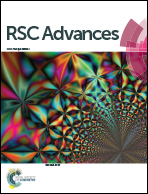Incorporation of 1,4-cyclohexanedicarboxylic acid into poly(butylene terephthalate)-b-poly(tetramethylene glycol) to alter thermal properties without compromising tensile and elastic properties†
Abstract
Thermal and tensile properties of thermoplastic elastomers (e.g. poly(butylene terephthalate)-b-poly(tetramethylene glycol) (PBT–PTMG)) are usually tuned by changing the composition of hard and soft segment parts. Simply increasing the amount of soft segment results in a lower melting temperature and better elastic properties, but the thermal stability and tensile properties are inevitably sacrificed. In this work, by incorporation of an aliphatic ring structure (i.e. 1,4-cyclohexanedicarboxylic acid) (CHDA) to partially replace the aromatic ring (i.e. terephthalic acid) in PBT-PTMG, the properties of the material can be tuned in such a way that the melting temperature decreases, while the thermal stability, tensile and elastic properties are not compromised. Moreover, manipulation of the stereo-chemistry of the CHDA unit discloses the “elastic” nature of the non-planar ring structure. Samples with a greater amount of cis-CHDA tend to have better tensile and elastic properties compared with their trans-CHDA counterparts.


 Please wait while we load your content...
Please wait while we load your content...